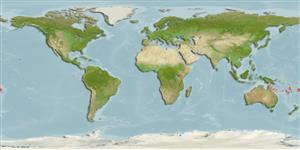Classification / Names
Common names | Synonyms | Catalog of Fishes(genus, species) | ITIS | CoL | WoRMS | Cloffa
Teleostei (teleosts) >
Blenniiformes (Blennies) >
Tripterygiidae (Triplefin blennies) > Tripterygiinae
Etymology: Helcogramma: Greek, helkos, -eos, -ous = ulcer, sore + Greek, gramma = letter, mark (Ref. 45335); cerasina: The specific epithet is derived from the Greek "cerasinus", meaning of cherry, and refers to the cherry-red colour of the anal fin. Cerasina is treated as Noun in apposition..
Environment: milieu / climate zone / depth range / distribution range
Ecology
Marine; benthopelagic; depth range 0 - 12 m (Ref. 52308). Tropical
Western Central Pacific: Tonga Islands and Fiji Islands.
Size / Weight / Age
Maturity: Lm ? range ? - ? cm
Max length : 4.3 cm SL male/unsexed; (Ref. 52308); 4.0 cm SL (female)
Short description
Identification keys | Morphology | Morphometrics
Dorsal spines (total): 17 - 18; Dorsal soft rays (total): 10 - 13; Anal spines: 1; Anal soft rays: 19 - 22; Vertebrae: 37 - 39. A species of Helcogramma (sensu Hansen, 1986) with 1-2 symphisial mandibular sensory pores, second dorsal fin spines XIV-XV (typically XIV), last ribs modally on vertebral centrum 12, vertebrae modally 11+27=38, 23-29 pored lateral line scales, nape without scales, and males with anal fin red in life becoming translucent in preservative.
Female members of the Tripterygiidae have eggs that are hemispherical and covered with numerous sticky threads that anchor them in the algae on the nesting sites (Ref. 240). Larvae are planktonic which occur primarily in shallow, nearshore waters (Ref. 94114).
Life cycle and mating behavior
Maturities | Reproduction | Spawnings | Egg(s) | Fecundities | Larvae
Williams, J.T. and J.C. Howe, 2003. Seven new species of the triplefin fish genus Helcogramma (Tripterygiidae) from the Indo-Pacific. aqua, J. Ichthyol. Aquat. Biol. 7(4):151-176. (Ref. 52308)
IUCN Red List Status (Ref. 130435)
Threat to humans
Harmless
Human uses
Tools
Special reports
Download XML
Internet sources
Estimates based on models
Preferred temperature (Ref.
123201): 25.2 - 27.6, mean 26.4 °C (based on 216 cells).
Phylogenetic diversity index (Ref.
82804): PD
50 = 0.5000 [Uniqueness, from 0.5 = low to 2.0 = high].
Bayesian length-weight: a=0.00562 (0.00258 - 0.01228), b=3.08 (2.89 - 3.27), in cm total length, based on LWR estimates for this (Sub)family-body shape (Ref.
93245).
Trophic level (Ref.
69278): 3.1 ±0.3 se; based on size and trophs of closest relatives
Resilience (Ref.
120179): High, minimum population doubling time less than 15 months (Preliminary K or Fecundity.).
Fishing Vulnerability (Ref.
59153): Low vulnerability (10 of 100).
